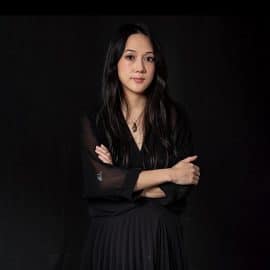


| PersonalBrand Presence | 8 / 10 |
| Authoritativeness | 4 / 10 |
| Expertise | 6 / 10 |
| Influence | 7 / 10 |
| Overall Rating | 6 / 10 |
As the artistic lead and founder of Scilicet, a studio based in London that delves into the collaboration between humans and non-humans, Sougwen Chung stands at the forefront of human-machine interaction. Her time as a research fellow at MIT's Media Lab allowed her to examine both human-made and machine-made impressions, gaining insights into the interplay of human systems.
Chung's accolades include the prestigious Lumen Prize for Art in Technology, being honored as Woman of the Year in Monaco, and being recognized for her excellence in the Arts & Sciences sector. She also made history as the inaugural E.A.T. Artist in Residence in collaboration with the New Museum and Bell Labs. Her project, Omnia per Omnia, received notable commissions, along with awards for her drawing from Japan Media Arts. Additionally, she was placed among Print Magazine’s Top 20 New Visual Artists. Furthermore, her residency stints include prominent institutions such as Google, Eyebeam, Japan Media Arts, Studio Wayne McGregor, Laurenz Haus Basel, and Pier 9 Autodesk.

Currently, the London House of Fine Art (HOFA) gallery features an exciting new exhibition named 'Relational Gestures,' showcasing selected works from Chung’s recent projects. The exhibition highlights innovative pieces, including her trademark paintings made with robotic assistance, AI models that draw upon her prior creations, and biofeedback tracking systems. Chung notes that her artistic methods have evolved in tandem with advancements in robotics.artificial intelligence In discussing the motivation behind her latest painting series, Chung emphasizes the themes of meditation and biofeedback, highlighting how concepts of urban mobility and contemporary neural networks have influenced her approach.
The most recent pieces in this exhibition reflect Chung's intrigue with new configurations of human-machine relationships linked to biofeedback mechanisms.
To create these works, Chung utilizes an EEG headset that captures her brainwave activity while she meditates. As a response to the biofeedback data, robotic assistants wield paintbrushes to replicate her strokes, enhancing the collaborative nature of her artistic process. While she champions cooperation in her interactions with AI, the broader artistic community is engaged in critical discussions surrounding the implications of this technology. Chung acknowledges multiple viewpoints on the dynamics between humans and AI, suggesting that this is a fertile area for ongoing dialogue. \"I find work that solely challenges the status quo to be particularly captivating as it combines profound intellectual depth with genuine passion,\" she states.
Let’s take a closer look at efforts that tap into the power of digital currencies to support charitable initiatives.
Know MoreAI is making its mark on healthcare in numerous ways, revealing new genetic links and driving advancements in robotic surgical technologies.
Know More